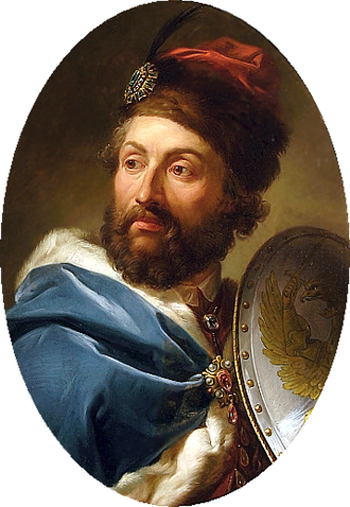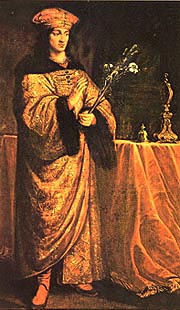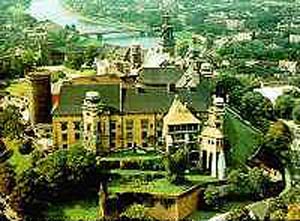 |
The Saint of the Day
St. Casimir – March 4
Prof. Plinio Corrêa de Oliveira
Biographical Note:

Casimir IV, father of the Saint
|
St. Casimir, prince of Poland, was born in the royal palace at Krakow on October 3, 1458.
When the King went to Lithuania to arrange affairs there, Casimir was placed in charge of Poland and from 1481 to 1483 administered the State with great prudence and justice.
About this time his father tried to arrange a marriage for him with the daughter of Frederick III, but Casimir preferred to remain single. Shortly afterward he fell sick, and died at the court of Grodno on March 3, 1484.
He is the patron saint of Poland and Lithuania.
Comments of Prof. Plinio:
I would like to emphasize that St. Casimir lived in the royal court of his parents, Casimir IV the Great and Queen Elizabeth of Habsburg, to point out that he lived his life at court and became a saint there.
Sometimes, because of a certain erroneous vision of sanctity, one is led to think that only persons in the religious life – priests, monks and nuns – can become saints. According to this mentality, it is so rare for a layperson to become a saint that one who does so should be considered an exception to the rule, a kind of miracle. However a lay saint is not an exception to the rule; it is the normal accomplishment of the plan of Divine Providence for lay persons.

St. Casimir lived his life at court and became a saint there
|
The fact that St. Casimir became a saint living in a royal court shows that the court was a place where one can live and be a saint. In this sense, it constitutes a kind of eulogy to the ambience in which he lived. This fact refutes the revolutionary propaganda that says that the courts were necessarily corrupt. Frequently, as we can verify on our calendar, there were saints who were kings and queens, saints who were princes and princesses, and saints who were nobles. Very often sanctity perfumed the courts. Therefore, those courts, instead of being seats of moral corruption and perdition, were often places where sanctity throve, flourished, and exerted a considerable influence.
In this sense, the ambience of court in many ways realized the ideal of Christian Civilization. What should an ideal court be in a Christian Civilization? The king is an earthly image of God, and his court should be an image of the heavenly court. In an ideal Catholic court, the saintly king would be surrounded by courtesans who should be images of the angels and saints before God thrice holy. Now, the fact that this ideal has been partially realized at certain times in History is something that should fill us with joy. These examples show that the Catholic courts were good, and they also demonstrate how the revolutionary propaganda lies when it talks about the courts.
Someone could object and say that in one thousand years of History, anyone can find anything to prove a thesis. Therefore, just because many saints can be found in the courts, this does not prove what I said.
I can answer this objection. First, the argument is not true. If it were true, we should have a proportional number of saints in the governments and representative houses of the liberal republican system. This system has been established almost everywhere since the American and French Revolutions – for more than 200 years. We do not find saints, however, flourishing in these political ambiences, but quite the opposite.

The royal castle at Krakow built by King Casimir IV |
Second, according to the laws of History, normally great virtue or great vice does not appear isolated. It appears, to use a metaphor, like a mountain peak on a whole chain of mountains. That means that if you have a saint in one place, surrounding him you normally have a number of people who are very good Catholics even though they are not saints, a greater number of upright people, and a multitude of just decent people.
Sanctity is the greatest fruit of a whole social group that aspires to follow Our Lord Jesus Christ. Therefore, by showing that many saints existed in the Catholic courts of times past, we demonstrate that those ambiences were compatible with sanctity and good on many levels. So, the saints who lived in those courts were not just exceptional cases, but reflections of the whole.
I think that St. Casimir is pleased that we are remembering these points about him. I hope and pray that from his heavenly throne he will protect us in our counter-revolutionary fight.


  | |
Prof. Plinio Corrêa de Oliveira | |
The Saint of the Day features highlights from the lives of saints based on comments made by the late Prof. Plinio Corrêa de Oliveira. Following the example of St. John Bosco who used to make similar talks for the boys of his College, each evening it was Prof. Plinio’s custom to make a short commentary on the lives of the next day’s saint in a meeting for youth in order to encourage them in the practice of virtue and love for the Catholic Church. TIA thought that its readers could profit from these valuable commentaries.
The texts of both the biographical data and the comments come from personal notes taken by Atila S. Guimarães from 1964 to 1995. Given the fact that the source is a personal notebook, it is possible that at times the biographic notes transcribed here will not rigorously follow the original text read by Prof. Plinio. The commentaries have also been adapted and translated for TIA’s site.
|
Saint of the Day | Home | Books | CDs | Search | Contact Us | Donate

© 2002- Tradition in Action, Inc. All Rights Reserved
|
 |
|